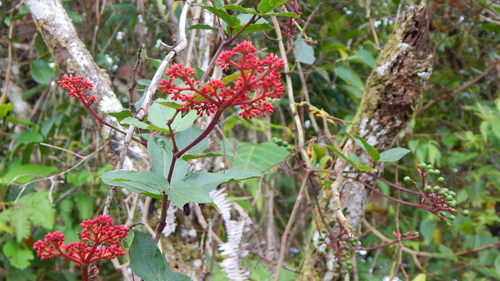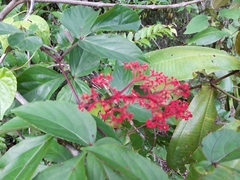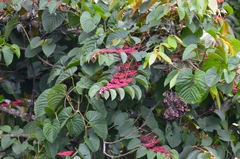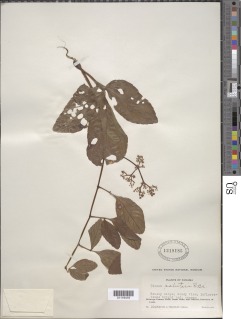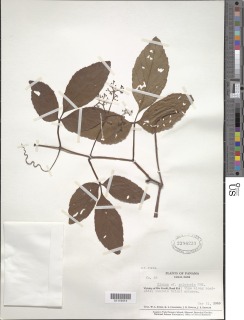

|
|
|
|
Family: Vitaceae
Caro-de-Tres-Hojas
|
Descripción: Plantas trepadoras o lianas con el tronco tetragonal. Ramitas cubiertas de pelos malpigiáceos de color rojizo. Hojas trifolioladas y alternas, folíolos de 4-15 x 2-8 cm, ovados o lanceolados, con ápice agudo, bordes dentados y base decurrente. Pecíolo de 2-6 cm de largo y de color rojizo. Inflorescencias axilares. Flores rojas o anaranjadas. Frutos en bayas globosas, de 0.4-0.8 cm de largo, verdes, tornándose negros al madurar. Especies Parecidas: A menudo se confunde con LK cissmi Cissus microcarpa LK2 , pero en C. microcarpa los folíolos presentan domacios en las axilas de las nervaduras secundarias del envés y las flores son rojas, blancas amarillas o verdes. Vine with simple tendrils, glabrous or with scattered pilose pubescence throughout; stems angled or winged on margins, usually maroon at nodes and speckled with maroon all over (not obvious on dried specimens), the older stems woody. Leaves trifoliolate; stipules ovate, subpersistent, minute (to 5 mm long); petioles 2-6 cm long, maroon at base and apex, angled and often winged on margins; leaflets crenate-serrate, the terminal one +/- elliptic, obtuse to bluntly acuminate at apex, cuneate at base, 4.5-16 cm. long, 1.5-8 cm wide, on a short petiolule, the lateral leaflets smaller than terminal leaflet, inequilateral, ovate to ovate-elliptic, acute to obtuse at apex, rounded to subcuneate at base, 3.5-12 cm. long, 2-6 cm wide. Cymes corymbiform, opposing leaves, congested in pseudoumbels; peduncles tetragonal, 5-12 cm long; flowers 4-parted, red; pedicels 2-5 mm long, villous; calyx cupular, the lobes short or obscure; petals valvate, acute at apex, cucullate within, often falling free at anthesis; stamens 4, set between notches in the thick disk, erect at anthesis, later recurved, somewhat reflexed; anthers open in bud; filaments and connective red; style short; stigma simple. Fruits orbicular, to 6 mm diam, purple-black at maturity; seeds usually 2. Croat 12943. Mexico to Colombia, Venezuela, the Guianas, Peru, and Bolivia; West Indies. In Panama, known from tropical moist forest in the Canal Zone, Colon, San Blas, Veraguas, Herrera, and Panama, from premontane moist forest in the Canal Zone and Los Santos, from premontane wet forest in Colon, Coclé, and Panama, and from tropical wet forest in Colon. |

